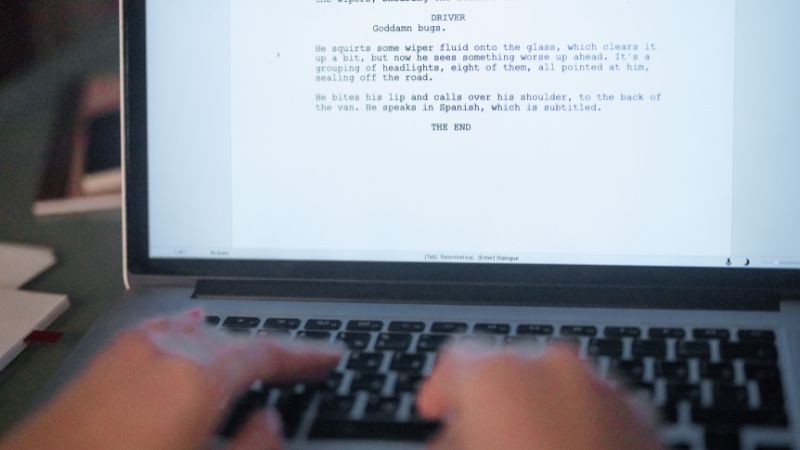A well-formatted script is the gateway to getting your story read. While a gripping plot and compelling characters are essential, a script riddled with formatting errors can be a death knell, signaling amateurism and a lack of respect for the industry. Screenwriting software has automated much of the process, but even with these tools, some common mistakes persist.

Here are 5 of the most frequent screenwriting formatting errors and how to avoid them.
1. The Overly Descriptive Action Line
Action lines (or scene description) are the workhorses of a screenplay, painting the visual picture of what’s happening on screen. However, many new writers fall into the trap of writing overly descriptive, prose-heavy action lines that read more like a novel than a script.
The mistake:
JOHN walks into the room. He is a tall, lanky man with a scruffy beard and kind eyes. He looks around, his gaze lingering on the worn, leather-bound books that line the walls. A small smile plays on his lips as he takes in the comforting atmosphere of the old study.
The fix:
JOHN enters the study. He’s tall, lanky. Scruffy beard. He smiles, taking in the old books that line the walls.
Why it matters: Action lines should be concise and to the point. Screenplays are blueprints for a visual medium, and directors and actors don’t need to be told what a character is thinking or feeling through prose. They need to know what they are doing. Keep it simple, active, and visual.
2. The Unnecessary Parenthetical
Parentheticals are a screenwriting tool used to provide an actor with a brief direction on how to deliver a line. They are often overused by new writers who feel the need to micro-manage an actor’s performance.
The mistake:
JANE
(angrily)
I can’t believe you did that!
The fix:
JANE
I can’t believe you did that!
Why it matters: Good dialogue should convey the emotion on its own. If you have to tell the actor how to deliver a line, the dialogue is likely not strong enough. Use parentheticals sparingly and only when the meaning of a line would be unclear without them (e.g., a sarcastic remark that could be misconstrued). Trust your words to do the work.
3. The Lack of Scene Heading Specificity
Scene headings (or slug lines) are crucial for organizing a script and telling the reader where and when a scene is taking place. A common mistake is using generic scene headings that lack the necessary detail.
The mistake:
INT. HOUSE – DAY
The fix:
INT. JOHN’S KITCHEN – DAY
Why it matters: The more specific you are, the easier it is for a reader to visualize the scene and keep track of the location. “House” could be anywhere; “John’s Kitchen” immediately grounds the reader in a specific place. It helps with production planning and ensures everyone on a film crew is on the same page.
4. Incorrect Character and Dialogue Formatting
This may seem like a basic error, but it’s one of the most common. Character names should be in all caps and centered above the dialogue block. Dialogue should be centered and contained within a specific width.
The mistake:
John
“I think we should leave now.”
The fix:
JOHN
I think we should leave now.
Why it matters: This isn’t just a matter of aesthetics; it’s about adhering to industry standards. Incorrect formatting of character and dialogue makes a script look unprofessional and can be jarring for a reader. It breaks the rhythm of the read and signals to the reader that the writer hasn’t done their homework.
5. Ignoring the “One-Inch Rule” for Action Lines
While most screenwriting software handles this automatically, understanding the principle behind it is important. Action lines should not run the full width of the page. They should be a single, uninterrupted block of text, starting at the left margin and ending at a specific point on the right (roughly one inch in from the right margin).
The mistake:
The long action line continues across the entire page, stretching to the far right margin, making it difficult to read and disrupting the visual flow of the script. It looks more like a novel than a screenplay and is a clear sign that the writer is not using industry-standard formatting.
The fix:
The action line is contained within a specific block, creating a clean, easy-to-read column of text that is visually pleasing and adheres to industry standards. It allows for a quick read and a better sense of pacing.
Why it matters: This formatting convention is more than just a stylistic choice. It’s about pacing. The shorter, more contained blocks of action and dialogue create a sense of rhythm that mimics the flow of a film. When action lines run too long, they slow down the reader and make the script feel sluggish.
Formatting is not a creative hurdle; it’s a fundamental part of the screenwriting craft. Mastering these basic rules shows that you are a serious writer who understands the industry and is ready to collaborate. While a brilliant story can overcome minor errors, a clean, professional-looking script tells the reader that you’ve put in the work, respect their time, and are ready for the big leagues. It’s the difference between a manuscript that gets a pass and one that gets a read.
